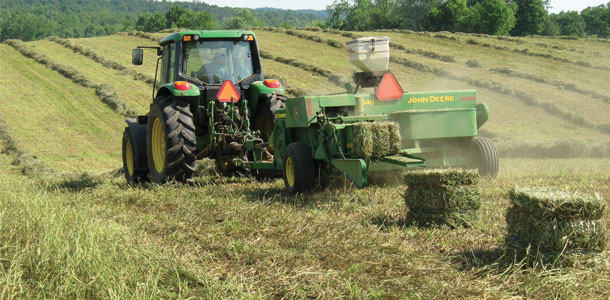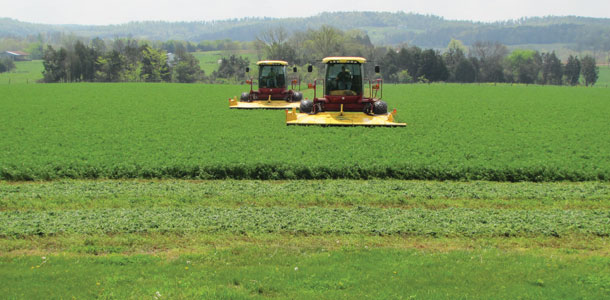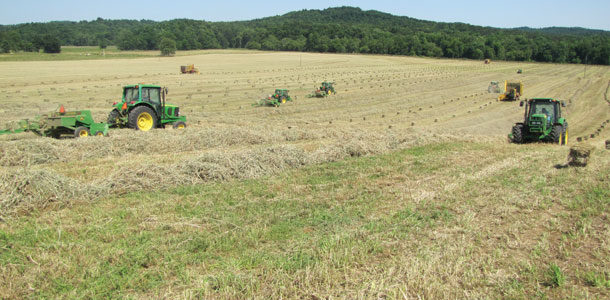But in the last three years, he has increased his acreage to 720 acres – a significant jump compared to his previous progress.
One of his keys to success has been the way he “rolls” equipment. Geralds, of Munfordville, Kentucky, buys his equipment brand-new, uses it for the first half of its life and sells it before he spends much money on repairs.
Sounds contrary to the maxim, “Use it up, wear it out, make it do or do without.” But it does save Geralds time and money.
Geralds has six small balers that are switched out of his fleet every four years. Within those four years, each baler will bale about 100,000 small bales.
Because the equipment was bought new, the balers won’t have any downtime during the hay season and minimal, if any, repairs. And when it comes time to sell, Geralds gets back half the money he paid for the balers in the first place.
“When we first started doing this, it was difficult. We were growing and replacing machinery at the same time. So we had to go from three balers to four balers to five balers to six balers – and keep them a shorter amount of time. And it was tough,” Geralds says.But he found it was worth it.
“Ten or 12 years ago, we were spending $40,000 to $50,000 a year on repairs. But now we’re down to probably $10,000 or $12,000 for all of our machinery.
That gives us a lot of extra capital, plus the labor that we were spending in the downtime and the hay we were losing from downtime. I feel like there’s more profit in the way that we’re doing it right now than there ever was, and a lot less stress,” Geralds says.
Geralds typically buys his balers for $24,000 and then sells them for $12,000. Since each baler makes about 100,000 bales before he sells it, the cost to buy a new baler every four years works out to $0.12 per bale. On top of that, he spends minimal amounts on repairs.
Geralds says, “If you’re going to get one every four years, it’s going to cost you $12,000. That’s $3,000 a year. Let’s say we kept a baler six years.
We got to looking and realized we were spending $3,500 to $4,000 in repairs on a baler in one year. It only cost us $3,000 a year when it was new.
So why in the world would I want to spend an extra $1,500 a year, plus the labor of putting the parts on, plus the fact that it’s not out in the field?”
Balers aren’t the only things that Geralds “rolls” on a regular basis. Rakes and tedders are used about six to eight years, and cutters about four to five years. Tractors are run only up to about 5,000 hours, and pickup trucks are only driven 100,000 miles.

But balers are the most key piece of equipment on his operation.
“You don’t ever want to have a square baler down. In a day we do 6,000 to 7,000 bales of hay, so we’re doing $50,000 to $60,000 worth of hay. So if one baler goes down, we’re going to lose $10,000 to $12,000 worth of hay,” Geralds says.
Because of this, good maintenance is important. Besides routine maintenance in the summer, every winter all the equipment is brought into the shop and checked over, adjusted and prepared for spring. It’s at this time that they catch any potential problems before they become an issue.
This also increases the value of his used equipment.
“When Clayton sells, he’s getting a good amount of money back. He takes good care of his stuff. They keep them inside, and you would never know the balers baled that much hay,” says Darrin Edlin, a sales representative from Limestone Farm, Lawn and Worksite.
Winter is also a time for record-keeping.
“With these larger producers, record-keeping is very important to know that they’re being efficient and productive with that equipment,” Edlin says.
On the Geralds farm they take that seriously. As a tradition, on Jan. 1 they look at every piece of equipment and write down how many miles, hours or bales it has done so far.

This helps them track what each piece of equipment is doing each year. This helps them know what is being used too little or too much. They then evaluate what they’ve been doing with the equipment and determine if they really need it.
While it’s not typical for smaller operations to have such a system for buying new equipment and “rolling” it before it breaks down, would such a system benefit them?
“Maybe you’re only baling 10,000 bales a year; that’s fine. Then your baler will last 10 years. But don’t try to run it 15. The last few years, it’s going to cost you more than when it was new. A lot of people don’t need six balers. The same rules would apply if you only had one,” Geralds says.
For those who want to start an equipment rotation system, Geralds doesn’t recommend jumping in too quickly and buying everything new right away. He suggests a long-term plan, deciding where you want to be in 10 years then moving toward the goal.
“Get a plan and head in that direction. Don’t just buy whatever you found on sale that week,” Geralds says.
Edlin also suggests finding a reputable equipment dealership in your area that you’re omfortable with, and “partnering up” with a salesman you trust.
“Discuss the needs, discuss the operation, discuss the different sales incentive programs that are available,” Edlin says. FG
Alisa Anderson Raty is a freelance writer based in Rexburg, Idaho.
PHOTOS
Several balers together are expected to bale 6,000 to 7,000 bales of hay per day at Geralds Hay Farms, so equipment has to perform reliably with minimal downtime. Photo courtesy of Geralds Hay Farms.











